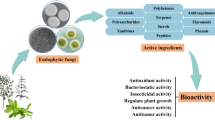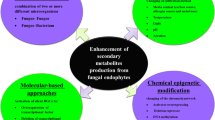Abstract
Gloriosa superba (L.) of the family Colchicaceae is a tuberous endangered plant, rich in several bioactive compounds like alkaloids and sterols. The tubers of the plant have medicinal value and are used to treat inflammation, skin infections, rheumatoid arthritis and other ailments. Since large-scale exploitation of the plant is detrimental to the biodiversity, the compounds obtained from other sources, especially the endophytes, which are known to produce the same bioactive compounds as that of the host plants are looked for. The endophytic fungi from roots, stem and leaves were isolated and identified based on morphotyping and ITS–DNA sequences. A total of 233 isolates were recovered from a total of 450 segments of root, stem and leaf. A large and diverse number of endophytic fungi were recovered from roots when compared to other parts of the plant. Bipolaris cynodontis, B. specifera, Fusarium oxysporum and F. solani were found as dominant colonizers of root in addition to Talaromyces pinophilus, Oidiodendron spp. and Colletotrichum gleosporioides. The isolated endophytes belonged to seven morphotypes: a majority of them were Hyphomycetes (65.21%), followed by Dothideomycetes (13.04%), Coelomycetes (8.69%), Sordariomycetes (4.34%), Eurotiomycetes (4.34%), Leotiomycetes (4.34%) and Zygomycetes (4.34%). The colonization frequency was found to be high in roots followed by stem and leaves. These endophytes could be exploited for screening novel secondary metabolites which can be used as therapeutic agents.



Similar content being viewed by others
References
Wani MC, Taylor HL, Wall ME, Coggon P, McPhail AT (1971) Plant antitumor agents. VI. Isolation and structure of taxol, a novel antileukemic and antitumor agent from Taxus brevifolia. J Am Chem Soc 93(9):2325–2327
Strobel GA (1998) Endophytic microbes embody pharmaceutical potential. ASM News 5:263–268
Strobel G, Daisy B (2003) Bioprospecting for microbial endophytes and their natural products. Microbiol Mol Biol Rev 67:491–502
Mahesh B, Tejesvi MV, Nalini MS, Prakash HS, Kini KR, Subbiah V, Shetty HS (2005) Endophytic mycoflora of inner bark of Azadirachta indica. Curr Sci 88(2):218–219
Oelmüller R, Sherameti I, Tripathi S, Varma A (2009) Piriformospora indica, a cultivable root endophyte with multiple biotechnological applications. Symbiosis 49(1):1–17
Paul NC, Kim WK, Woo SK, Park MS, Yu SH (2007) Fungal endophytes in roots of Aralia species and their antifungal activity. Plant Pathol J 23(4):287
Tejesvi MV, Kini KR, Prakash HS, Subbiah V, Shetty HS (2007) Genetic diversity and antifungal activity of species of Pestalotiopsis isolated as endophytes from medicinal plants. Fungal Divers 24:37–54
Mathur A, Verma SK, Singh SK, Mathur D, Prasad GBKS, Dua VK (2011) Investigation of anti-inflammatory properties of Swertia chirayta and Gloriosa superba. Recent Res Sci Technol 3(3):40–43
Ade R, Rai MK (2009) Current advances in Gloriosa superba L. Biodivers J Biol Divers. https://doi.org/10.13057/biodiv/d100409
Imazio M, Bobbio M, Cecchi E, Demarie D, Demichelis B, Pomari F, Belli R (2005) Colchicine in addition to conventional therapy for acute pericarditis: results of the Colchicine for acute Pericarditis (COPE) trial. Circulation 112(13):2012–2016
Nadkarni KN (2002) The Indian material medica, 3rd edn. Popular Prakashan, Mumbai, pp 1186–1188
Schulz B, Wanke U, Draeger S, Aust HJ (1993) Endophytes from herbaceous plants and shrubs: effectiveness of surface sterilization methods. Mycol Res 97(12):1447–1450
Barnett HL, Hunter BB (1972) Illustrated genera of imperfect fungi. Illustrated genera of imperfect fungi, vol 241, 3rd edn. Burgess Publishing Co., Minneapolis
Doyle JJ, Doyle JL (1987) A rapid DNA isolation procedure for small quantities of fresh leaf tissue. Phytochem Bull 19:11–15
White TJ, Bruns T, Lee S, Taylor JW (1990) Amplification and direct sequencing of fungal ribosomal RNA genes for phylogenetics. In: Innis MA, Gelfand DH, Sninsky JJ, White TJ (eds) PCR protocols: a guide to methods and applications. Academic Press, New York, pp 315–322
Fisher PJ, Petrini O (1987) Location of fungal endophytes in tissues of Suaeda fruticosa: a preliminary study. Trans Br Mycol Soc 89(2):246–249
Budhiraja A, Kumar S, Nepali K, Kaul S, Dhar KL (2013) Community analysis of endophytic fungi in medicinal plant Gloriosa superba. Adv Hum Biol 3(1):15–20
Arnold AE, Lutzoni F (2007) Diversity and host range of foliar fungal endophytes: are tropical leaves biodiversity hotspots? Ecology 88(3):541–549
Samaga PV, Rai VR (2016) Diversity and bioactive potential of endophytic fungi from Nothapodytes foetida, Hypericum mysorense and Hypericum japonicum collected from Western Ghats of India. Ann Microbiol 66:229–244
Zhai MM, Niu HT, Li J, Xiao H, Shi YP, Di DL, Crews P, Wu QX (2015) Talaromycolides A–C, novel phenyl substituted phthalides isolated from the green Chinese onion-derived fungus Talaromyces pinophilus AF-02. J Agric Food Chem 63:9558–9564
Zheng N, Yao F, Liang X, Liu Q, Xu W, Liang Y, Yang R (2018) A new phthalide from the endophytic fungus Xylaria sp. GDG-102. Nat Prod Res 32(7):755–760
Wei X, Chen J, Zhang C, Pan D (2016) A new Oidiodendron maius strain isolated from Rhododendron fortunei and its effects on nitrogen uptake and plant growth. Front Microbiol 7:1327
Lee BH, Han HK, Kwon HJ, Eom AH (2015) Diversity of endophytic fungi isolated from roots of Cypripedium japonicum and C. macranthum in Korea. Korean J Mycol 43:20–25
Rosmana A, Nasaruddin N, Hendarto H, Hakkar AA, Agriansyah N (2016) Endophytic association of Trichoderma asperellum within Theobroma cacao suppresses vascular streak dieback incidence and promotes side graft growth. Mycobiology 44(3):180–186
Faisal MP, Prasad L (2016) A potential source of methyl-eugenol from secondary metabolite of Rhizopus oryzae 6975. Int J Appl Biol Pharm Technol 7:187–193
Ratnaweera PB, de Silva ED, Williams DE, Andersen RJ (2015) Antimicrobial activities of endophytic fungi obtained from the arid zone invasive plant Opuntia dillenii and the isolation of equisetin, from endophytic Fusarium sp. BMC Complement Altern Med 15(1):220
Chomcheon P, Wiyakrutta S, Aree T, Sriubolmas N, Ngamrojanavanich N, Mahidol CS (2010) Curvularides A-E: antifungal hybrid peptide–polyketides from the endophytic fungus Curvularia geniculata. Chem Eur J 16(36):11178–11185
Phuwapraisirisan P, Sawang K, Siripong P, Tip-Pyang S (2007) Anhydrocochlioquinone A, a new antitumor compound from Bipolaris oryzae. Tetrahedron Lett 48(30):5193–5195
Lu H, Zou WX, Meng JC, Hu J, Tan RX (2000) New bioactive metabolites produced by Colletotrichum sp., an endophytic fungus in Artemisia annua. Plant Sci 151(1):67–73
Yates IE, Bacon CW, Hinton DM (1997) Effects of endophytic infection by Fusarium moniliforme on corn growth and cellular morphology. Plant Dis 81(7):723–728
Acknowledgements
The authors would like to acknowledge Institute of Excellence, Vijnan Bhavan, for providing instrumentation facilities.
Author information
Authors and Affiliations
Corresponding author
Ethics declarations
Conflict of interest
The authors declare that there is no conflict of interest to publish this manuscript.
Additional information
Significance statements The isolation of endophytes from an important medicinal plant, Gloriosa superba (L.), revealed that root endophytic fungi are of special interest since the root of the plant is bestowed with maximum medicinal values. This work highlights the endophytic profile in different parts of the plant like root, stem and leaves collected from different habitats, pinpointing the relative dominance and colonization frequency, confirming the regional specificity and tissue specificity of the isolated endophytes.
Rights and permissions
About this article
Cite this article
Shobha, M., Sampath Kumara, K.K. & Prakash, H.S. Fungal Endophytes Associated with Gloriosa superba (L.). Proc. Natl. Acad. Sci., India, Sect. B Biol. Sci. 89, 1335–1342 (2019). https://doi.org/10.1007/s40011-018-1053-2
Received:
Revised:
Accepted:
Published:
Issue Date:
DOI: https://doi.org/10.1007/s40011-018-1053-2




